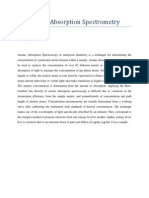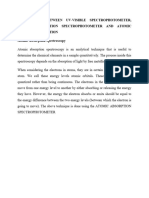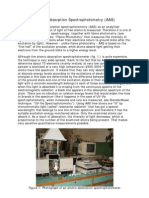0 ratings0% found this document useful (0 votes)
8 viewsAtomic Spectros
Uploaded by
Ralph Rezin MooreCopyright
© © All Rights Reserved
Available Formats
Download as PPT, PDF, TXT or read online on Scribd
0 ratings0% found this document useful (0 votes)
8 viewsAtomic Spectros
Uploaded by
Ralph Rezin MooreCopyright
© © All Rights Reserved
Available Formats
Download as PPT, PDF, TXT or read online on Scribd
You are on page 1/ 13
Atomic emission spectra
When an element is heated, it will absorb
energy. It’s electrons will move to higher
energy levels and fall back down to the
ground state, emitting light which can be
analysed.
Each element has a unique set of energy
levels, so when the electrons move
between the energy levels, it will involve
absorption and emission of energy
particular to that element. This means that
every element will emit light with a
different set of wavelengths to every other
element.
Excited electrons return to lower
energy levels emitting energy
• E1=Energy in ground state
• E2=Energy in excited stated.
• Overall energy= E1-E2
Line emission spectra:
Spectrum unique to each element
Use emission spectroscopy:
Emission spectroscopy is a qualitative tool –
it can identify elements present in a
sample but does not measure how much
of each is present.
Atomic absorption spectra
• A technique used to identify the presence
and concentration of substances by
analysing the spectrum produced when a
substance is vaporised and absorbs
certain frequencies of light.
• AAS is used particularly for detecting the
concentrations of metal ions in solutions.
How absorption spectroscopy is
done:
1. In AAS a hollow cathode lamp of the
metal being analysed is used. This
provides the specific wavelengths of light
particular to that element.
2. The sample is vaporised in a flame which
turns substances it contains into atoms.
The light from the lamp passes through
the vaporised sample. The element being
investigated will absorb the specific
wavelengths of light.
3. A particular chosen wavelength is
selected using a monochromator and the
intensity of that light is measured by a
detector. When the substance is not
present the maximum amount of light will
be detected. When the concentration of
the substances increases the element will
absorb more of the specific wavelength of
light and less of this light will get through.
Involves the use of a calibration
graph.
You might also like
- Biology WA ATAR Units 3 & 4 Student Book With 1 X 26 Month NelsonNetBook Access Code100% (1)Biology WA ATAR Units 3 & 4 Student Book With 1 X 26 Month NelsonNetBook Access Code547 pages
- Methods OT Lee Textbook NOT COMPRESSED (HIGHER QUALITY)No ratings yetMethods OT Lee Textbook NOT COMPRESSED (HIGHER QUALITY)265 pages
- Methods OT Lee Revision Series SOLUTIONSNo ratings yetMethods OT Lee Revision Series SOLUTIONS114 pages
- Atomic Absorption Spectrometry in Pharmaceutical AnalysisNo ratings yetAtomic Absorption Spectrometry in Pharmaceutical Analysis7 pages
- Atomic Absorption Spectroscopy: Basic PrincipleNo ratings yetAtomic Absorption Spectroscopy: Basic Principle7 pages
- Atomic Absorption Spectroscopy (AAS) : Dr. Chotimah, M.SiNo ratings yetAtomic Absorption Spectroscopy (AAS) : Dr. Chotimah, M.Si60 pages
- Introduction to Analytical Techniques CHE 438 Lecture 7 23 September 2024No ratings yetIntroduction to Analytical Techniques CHE 438 Lecture 7 23 September 202476 pages
- APznzaYyXuPnLDOkOrjgdrtwp0XMAel8EzJq7V3f11DjTRQjxRi-bluh7KCHA6ZZWJwfOk1enM3-OUyuWEfDyBxw9fJyZwnDSBwt_LPa174GqDKjXjf4NqVVA1fmkmFZCj8kOEplwkYa6jLy2IbxcdQDfvE_G4486Nvo2rX2-RGK0BJ-sHILI4kr7rMMD73v8CyrJaOQyTM2zPVeNo ratings yetAPznzaYyXuPnLDOkOrjgdrtwp0XMAel8EzJq7V3f11DjTRQjxRi-bluh7KCHA6ZZWJwfOk1enM3-OUyuWEfDyBxw9fJyZwnDSBwt_LPa174GqDKjXjf4NqVVA1fmkmFZCj8kOEplwkYa6jLy2IbxcdQDfvE_G4486Nvo2rX2-RGK0BJ-sHILI4kr7rMMD73v8CyrJaOQyTM2zPVe46 pages
- Elemental Analysis - Atomic Spectroscopy: A) IntroductionNo ratings yetElemental Analysis - Atomic Spectroscopy: A) Introduction40 pages
- AAS, AES, Flame AAS & AES with Plasma SourceNo ratings yetAAS, AES, Flame AAS & AES with Plasma Source53 pages
- Atomic Absorption Spectroscopy Written ReportNo ratings yetAtomic Absorption Spectroscopy Written Report7 pages
- Atomic Emission Spectroscopy: Flame Element Atomic Spectral Line AtomsNo ratings yetAtomic Emission Spectroscopy: Flame Element Atomic Spectral Line Atoms36 pages
- Spectroscopy: Light Interacting With Matter As An Analytical ToolNo ratings yetSpectroscopy: Light Interacting With Matter As An Analytical Tool29 pages
- Atomic Absorption Spectrophotometry (AAS)No ratings yetAtomic Absorption Spectrophotometry (AAS)4 pages
- Photometry: Science, Sensitivity, and Its Connection to AstronomyFrom EverandPhotometry: Science, Sensitivity, and Its Connection to AstronomyNo ratings yet
- 2023 HBL Unit 1 Exam Booklet One MCQ and Sa100% (1)2023 HBL Unit 1 Exam Booklet One MCQ and Sa27 pages
- Toaz - Info Davies The Trompowsky 2nd Edition PRNo ratings yetToaz - Info Davies The Trompowsky 2nd Edition PR145 pages
- 8 Ex 4C Differentiating X N When N Is NegativeNo ratings yet8 Ex 4C Differentiating X N When N Is Negative12 pages

























































































